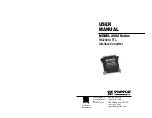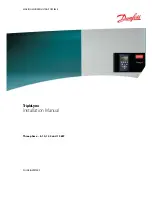
8. BATTERY REQUIREMENTS:
Battery type and battery size strongly affect the performance of the power inverter.
Therefore, you need to identify the type of loads your inverter will be powering and
how much you will be using them between charges. To determine the minimum
battery size that you need to operate appliances, follow these steps:
•
Determine the wattage of each appliance and/or tool you will need to
simultaneously operate fromhe inverter. To do this, read the labels on the
requirement to be operated. Usually, power consumption s shown in watts. If it
is shown in amps, multiply by 220V to determine the wattage.
•
Estimate the number of hours the equipment will be in use before recharge the
battery.
•
Determine the total watt-hours of energy use, multiply the total running time
and the average power consumption power (in watts) and then divide it by 10 if
12V system, by 20 if 24V system. This result is the Ah energy needed to supply
the loads considered above.
•
The minimum capacity of the battery, should be at least double the value of Ah
just obtained above.
Notes:
Some appliances require an higher surge power to start, then the power
consumption decreases. And some appliances are not operating for long
periods of time. For example, a typical home-use coffee maker draws 500watts
during its brew time of 5minutes, but it maintains the temperature of the pot at
about 100watts. The typical use of a microwave is only for a few minutes,
sometimes at lower power; some exceptions to brief operating times are lamps,
TVs and computers.
When possible, recharge your batteries when they are about 50% discharged or
earlier. This gives the batteries a much longer life cycle than recharging when they
are more deeply discharged.
11











































